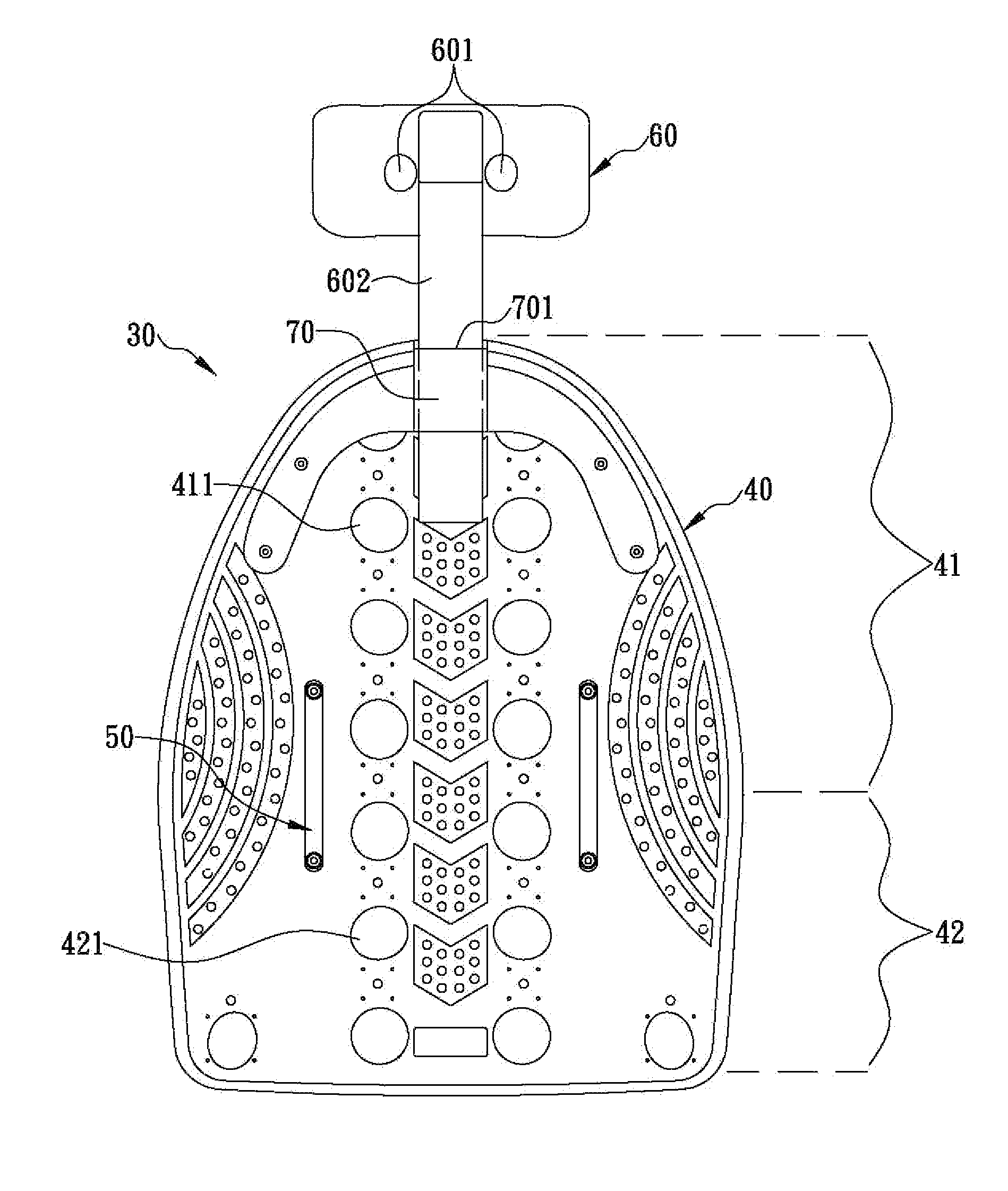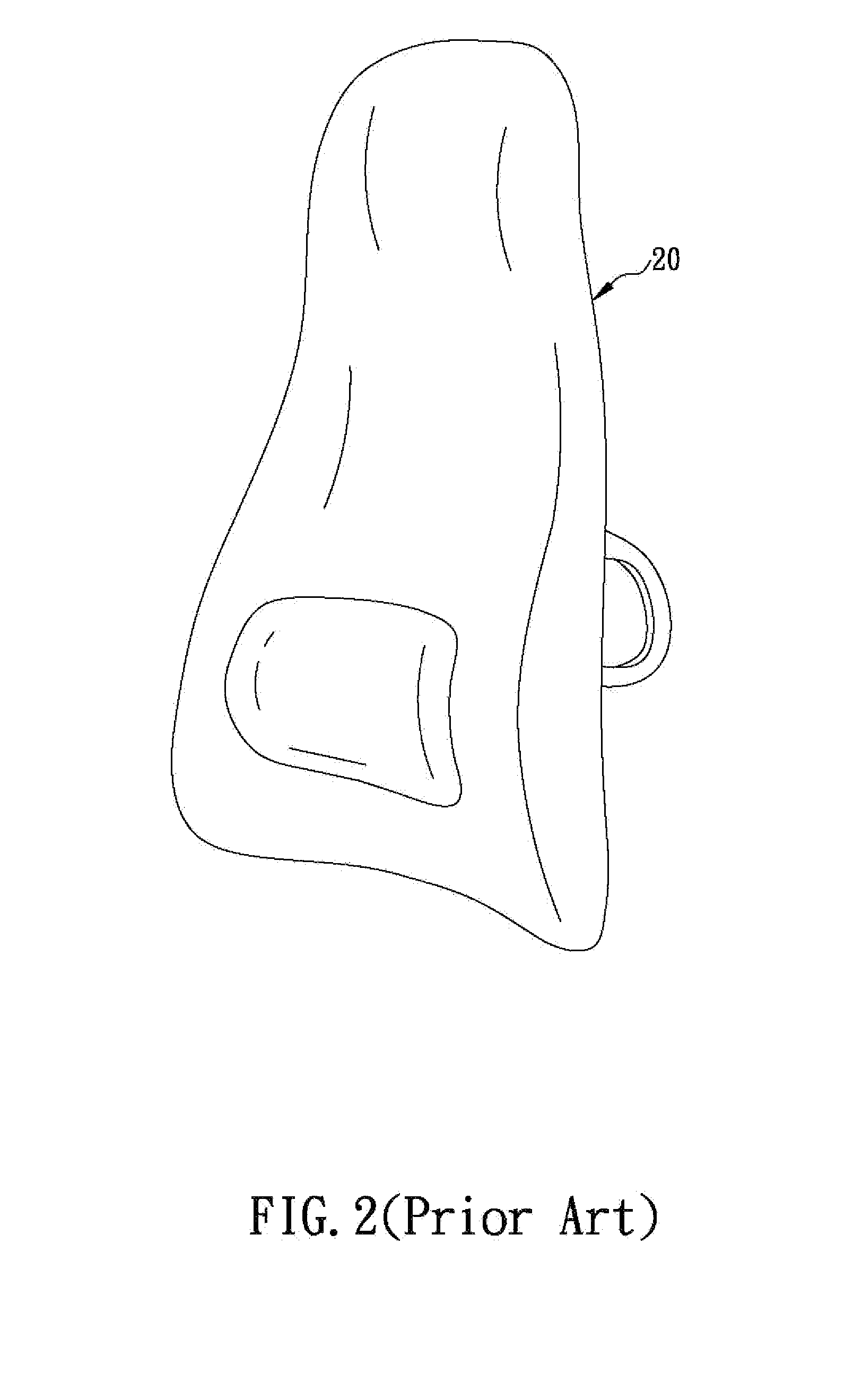(1) The curve of the hard board in either conventional backrest 10, 20—particularly the curve of the inner side (i.e., the user facing side) of the central longitudinal cross-section of the hard board—does not conform to the S-shaped curve jointly created by the kyphotic curve of the human
thoracic spine and the lordotic curve of the human
lumbar spine as shown in FIG. 3. Therefore, the hard boards themselves are totally incapable of properly and stably supporting the user's
thoracic vertebrae T1˜T12 and
lumbar vertebrae L1˜L5 and the surrounding
muscle tissues. To compensate for this shortcoming of the conventional backrests 10 and 20, the hard boards are covered with the aforesaid foam cushions, whose configurations and elasticity can make the user feel that their upper and lower back is well supported. Nevertheless, this “feel” of support is only an imaginary support simulated by the foam cushions but not a substantial, proper, stable support. After long term use, the conventional backrests 10 and 20 tend to lose all their expected supporting abilities due to deformation of the foam cushions, or even cause the thoracic vertebrae T1˜T12, the lumber vertebrae L1˜L5, and the surrounding
muscle tissues to shift to improper positions, which is contrary to the essential purpose of using the backrests 10 and 20: to fine-tune or correct the positions of the
cervical vertebrae C1˜C7, the thoracic vertebrae T1˜T12, and the lumbar vertebrae L1˜L5.
(2) The elasticity of the foam cushions, when new, often render the inner sides (i.e., the user facing sides) of the conventional backrests 10 and 20 too soft. Once the foam cushions show elastic fatigue after long term use, however, the inner sides of the backrests will become exceptionally stiff because of the material properties of the hard boards. In either case, the conventional backrests 10 and 20 fail to provide proper and stable support for the user's thoracic vertebrae T1˜T12 and lumber vertebrae L1˜L5 and the surrounding
muscle tissues. Rather, the conventional backrests 10 and 20 are very likely to fatigue the foregoing vertebrae and muscle tissues by supporting them at the wrong positions. Should that happen, the user may adjust their
sitting posture incorrectly, and an incorrect
sitting posture may eventually shift the thoracic vertebrae T1˜T12, the lumber vertebrae L1˜L5, and the surrounding muscle tissues to improper positions.
(3) The conventional backrests 10 and 20 are bulky. When placed against the backrest of a chair, they tend to occupy so much sitting space that the user's
buttocks cannot be correctly positioned. As a result, referring back to FIG. 3, the user's sacral vertebrae S will not form the normal S-shaped curve with the lumbar vertebrae L1˜L5 and thoracic vertebrae T1˜T12 above, and the surrounding muscle tissues will be tense and cannot be easily relaxed. In particular, when disposed against the backrest of the driver's seat in an automobile, the conventional backrests 10 and 20 often take up too much sitting space and thus deprive the user's
buttocks of sufficient support, making it difficult for the user's feet to operate the
throttle pedal or the
brake pedal properly, which is dangerous.
(4) The conventional backrests 10 and 20 are seat cushions at best. While they provide a comfortable sitting environment at the beginning, they become useless as soon as the comfortable feel is gone. Discarding the backrests, however, is a waste of resources and environmentally unfriendly.
(5) The conventional backrests 10 and 20 are incapable of applying
acupressure to the user's back. Nor can they be installed with electrodes which work with
electrotherapy devices to electrically stimulate the acupoints on the user's back.
(6) Referring to FIGS. 1, 2, and 3, the conventional backrests 10 and 20 are not designed to support the user's
cervical vertebrae C1˜C7, and yet a twisted
cervical spine may gradually shift the thoracic vertebrae T1˜T12, the lumbar vertebrae L1˜L5, and the surrounding muscle tissues to improper positions.
 Login to View More
Login to View More  Login to View More
Login to View More 


